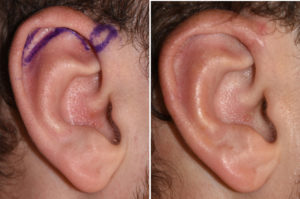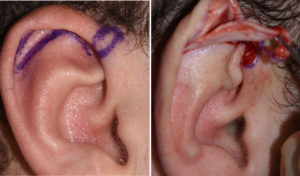Background: Vertical reduction of the ear is an uncommon otoplasty procedure as it is infrequently requested. It is best known and used in the treatment of macrotia where the entire ear is very large and vertically long. Macrotia reduction most commonly uses a ‘high and low’ technique where the upper helix (high) and the earlobe (low) are reduced. Put together a substantial reduction in ear height of 10 to 15mms can be achieved.
But not every vertical ear reduction has to be dramatic or requires a two level approach to it. In smaller vertical ear reductions the procedure can be limited to either the upper ear or just the earlobe. But when the patient has a concern about the shape of their upper ear (along with any height concerns) then an isolated upper ear reduction may be useful.
The reduction of the upper ear comes from removal of a portion of the scapha. The scapha is the depression or groove between the helix and the anthelix. It is composed of cartilage with skin on both of its sides. While it can be reduced on its own that will result in only a few millimeters of vertical height reduction. And if too much is removed will cause a distortion in the natural curvature of the upper helix. Adequate scaphal reduction requires removal of a portion of the helical rim as well.
Case Study: This patient wanted to have one ear lowered at its upper third to match better to the shape of the opposite ear. Even though the ear that was asked to be lower was the more normal shape, the patient correctly surmised that it was easier t lower the height of the upper helix than it was to raise it.

Vertical ear reduction of the upper ear is done by excision of a portion of the scapha. It can only cause a visible reduction of height by a corresponding helical rim excision whose length matches the amount of vertical reduction desired. It can be based either anteriorly by a mid-helical rim excision or posteriorly by a superior helical rim excision. How one wants the shape of the top of the ear to look determines how to base the scaphal reduction flap.
Highlights:
1) Vertical reduction of the upper ear is done through a scaphal removal technique
2) A scaphal reduction is a pedicled ear flap that can be based off the superior root of the helix or off the midportion of the helical rim.
3) The choice of which scaphal reduction method depends on the desired shape of the upper ear after reduction and the location of the scar.
Dr. Barry Eppley
Indianapolis, Indiana



